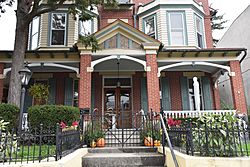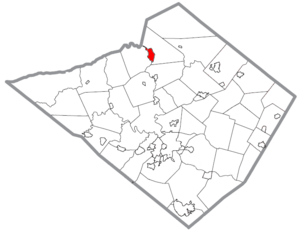Hamburg, Pennsylvania facts for kids
Quick facts for kids
Hamburg, Pennsylvania
Hambarig
|
|
|---|---|

House on North Fourth Street
|
|

Location of Hamburg in Berks County, Pennsylvania.
|
|
| Country | United States |
| State | Pennsylvania |
| County | Berks |
| Area | |
| • Total | 1.96 sq mi (5.08 km2) |
| • Land | 1.89 sq mi (4.89 km2) |
| • Water | 0.07 sq mi (0.19 km2) |
| Elevation | 397 ft (121 m) |
| Population
(2020)
|
|
| • Total | 4,270 |
| • Estimate
(2019)
|
4,355 |
| • Density | 2,307.90/sq mi (890.89/km2) |
| Time zone | UTC-5 (EST) |
| • Summer (DST) | UTC-4 (EDT) |
| ZIP Code |
19526
|
| Area codes | 610 and 484 (610 Exchange: 562) (484 Exhange: 665) |
| FIPS code | 42-32120 |
Hamburg (Pennsylvania German: Hambarig) is a borough in Berks County, Pennsylvania, United States. The population was 4,270 at the 2020 census. The town is thought to have been named after Hamburg, Germany, but this is likely to have been a corruption of Bad Homburg.
Contents
Geography
Hamburg is located in northern Berks County at 40°33′0″N 75°59′0″W / 40.55000°N 75.98333°W (40.556271, -75.982667), on the east bank of the Schuylkill River. It is bordered on the north, east, and south by Windsor Township and on the west, across the river, by West Hamburg in Tilden Township.
According to the United States Census Bureau, Hamburg has a total area of 1.9 square miles (5.0 km2), of which 1.9 square miles (4.9 km2) is land and 0.08 square miles (0.2 km2), or 3.55%, is water.
Demographics
| Historical population | |||
|---|---|---|---|
| Census | Pop. | %± | |
| 1800 | 329 | — | |
| 1830 | 560 | — | |
| 1850 | 1,035 | — | |
| 1860 | 1,334 | 28.9% | |
| 1870 | 1,590 | 19.2% | |
| 1880 | 2,010 | 26.4% | |
| 1890 | 2,127 | 5.8% | |
| 1900 | 2,315 | 8.8% | |
| 1910 | 2,301 | −0.6% | |
| 1920 | 2,764 | 20.1% | |
| 1930 | 3,637 | 31.6% | |
| 1940 | 3,717 | 2.2% | |
| 1950 | 3,805 | 2.4% | |
| 1960 | 3,747 | −1.5% | |
| 1970 | 3,909 | 4.3% | |
| 1980 | 4,011 | 2.6% | |
| 1990 | 3,987 | −0.6% | |
| 2000 | 4,114 | 3.2% | |
| 2010 | 4,289 | 4.3% | |
| 2019 (est.) | 4,355 | 1.5% | |
| Sources: | |||
As of the census of 2000, there were 4,114 people, 1,824 households, and 1,156 families residing in the borough. The population density was 2,212.2 people per square mile (854.0/km2). There were 1,932 housing units at an average density of 1,038.9 per square mile (401.0/km2). The racial makeup of the borough was 97.91% White, 0.34% African American, 0.12% Native American, 0.32% Asian, 0.49% from other races, and 0.83% from two or more races. Hispanic or Latino of any race were 0.83% of the population.
There were 1,824 households, out of which 25.7% had children under the age of 18 living with them, 50.7% were married couples living together, 9.1% had a female householder with no husband present, and 36.6% were non-families. 31.9% of all households were made up of individuals, and 16.9% had someone living alone who was 65 years of age or older. The average household size was 2.26 and the average family size was 2.82.
In the borough the population was spread out, with 21.1% under the age of 18, 7.2% from 18 to 24, 27.8% from 25 to 44, 23.4% from 45 to 64, and 20.6% who were 65 years of age or older. The median age was 40 years. For every 100 females, there were 88.8 males. For every 100 females age 18 and over, there were 84.1 males.
The median income for a household in the borough was $37,683, and the median income for a family was $50,957. Males had a median income of $37,650 versus $22,308 for females. The per capita income for the borough was $20,689. About 5.1% of families and 6.2% of the population were below the poverty line, including 11.4% of those under age 18 and 4.2% of those age 65 or over.
History
In 1779, Martin Kaercher Jr. received 250 acres (1.0 km2) of land from his father and divided it into building lots, naming the area "Kaercher Stadt". Hamburg was officially founded in 1787, named after the "German Hamburg" due to the largely German population of the region. On July 1, 1798 Hamburg became the second town with postal designation in Berks County, preceded only by Reading.
The Centre Turnpike was created in 1812 running between the two cities of Reading and Pottsville. Hamburg began to grow rapidly due to the close proximity of a major roadway. Eight years later (1820) the Schuylkill Canal was completed, followed quickly by railroad lines. Both of these advances in infrastructure had stops in Hamburg and boosted its population.
Hamburg Borough was officially organized in 1837.
The Hamburg Historic District, Hamburg Armory, and Hamburg Public Library are listed on the National Register of Historic Places.
The King Frost Parade
In 1910, Jack Walker formed a committee to organize a large fall parade in the town of Hamburg. With a budget of just over $100 earned from contributors, Walker was able to advertise and prepare the town for a parade that consisted of four full divisions. The event consisted of individual marchers, bands, community groups from all over Pennsylvania who would sponsor horse drawn floats.
The Keystone Social Club revived the parade from 1921 to 1924. They also agreed to sponsor the parade again in 1940.
In 1964, the Hamburg Jaycees once again began funding the parade, spurring the interest of 2,200 marchers alongside 50 floats. The King Frost Parade has been a presence in the town ever since and boasts the title of "Largest Fall Extravaganza Parade on the East Coast". With an average crowd of 20,000 and a budget over $30,000, this is one of Hamburg's largest public events. The few restrictions in place are the date to begin placing chairs, no politically oriented groups, and the bars close once the parade begins.
Taste of Hamburg-er Festival
Beginning in 2003, Hamburg welcomed a second large-scale public event to its town called Taste of Hamburg-er Festival, the East Coast's Premiere Hamburger Event. The festival is held annually on Labor Day Saturday and has seen a 40% growth each year. The most recent event was held on August 31, 2013, 10am-6pm.
In 2012, the festival drew over 30,000 people, with over 25 hamburger stands, three stages of non-stop entertainment, dozens of artisans and crafters, contests throughout the day, children's activities, and plenty of entertainment for the whole family.
It never stopped and returns for 3 September 2016. [1]
Recreation
Hamburg has multiple sites where recreational activities such as athletics, hiking, and fishing are able to take place. The area around the high school contains two soccer fields, two baseball fields, two softball fields, six tennis courts, a football field, and a field hockey field. These outdoor fields are open to public use during the sports offseason. There are also two basketball courts located inside the school and a third within the middle school.
There are two official parks, one in the center of town, and Kaercher Creek Park which is outside the borough to the east. The center park offers four basketball courts, a baseball field, a swimming pool, little league baseball and soccer fields, playground equipment, two pavilions and a cleared trail that runs along the edge of the Schuylkill River. During the summer months there are daily activities run by park leader. Kaercher Creek Park surrounds a large manmade lake that is open to fishermen and contains a loading/unloading boat ramp. The park's 40 acres (160,000 m2) also contain trails through the hillside, pavilions, grills, a playground and a volleyball court.
Further upriver from the central park is the Kernsville Dam. There is a boat loading/unloading ramp upstream from the dam itself with mid-river water levels varying from 6 to 15 feet (1.8 to 4.6 m). There are extensive trails on both sides of the river that run through the woods, leading to a small beach on the river's west side and an unused quarry on the east.
Transportation
The Interstate 78/U.S. Route 22 freeway passes through the borough, with access from Exit 30 (North 4th Street). It is 28 miles (45 km) west of Allentown and 54 miles (87 km) east of Harrisburg, the state capital. Pennsylvania Route 61 passes through the southern part of the borough, leading south 16 miles (26 km) to Reading and north 18 miles (29 km) to Pottsville.
Berks Area Regional Transportation Authority (BARTA) provides bus service to Hamburg along Route 20, which heads south along PA 61 to the BARTA Transportation Center in Reading. There is a park and ride lot at the Redner's in Hamburg that is served by BARTA. Schuylkill Transportation System provides bus service to Hamburg along Route 80, which heads north into Schuylkill County to Union Station Intermodal Transit Center in Pottsville.
Passenger rail service connected Hamburg at one time to Reading and Philadelphia to the east and Pottsville to the west via the Philadelphia and Reading main line, later the Reading Railroad Pottsville Branch and later the Pottsville Line until 1981 when services ceased after all diesel services were discontinued by SEPTA. The Reading Blue Mountain and Northern Railroad provides freight service to Hamburg, with a branch line running south from Hamburg to Temple and its Reading Division mainline passing through West Hamburg.
Notable people
- Jack Rowe, 19th Century baseball star, was born in Hamburg
- Richard Etchberger, United States Air Force member awarded Medal of Honor in Vietnam War, was born in Hamburg
- Fern Shollenberger, professional baseball player, was born in Hamburg
- Bill Beckley, Noted narrative/conceptual artist, was born in Hamburg
See also
 In Spanish: Hamburg (Pensilvania) para niños
In Spanish: Hamburg (Pensilvania) para niños



